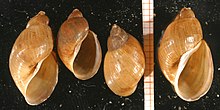Peregriana peregra
This taxon may be invalid (unaccepted). (Jan 2019) |
| Peregriana peregra | |
|---|---|

| |
| Four shells of Radix peregra, scale bar shows cm and mm | |
| Scientific classification | |
| Kingdom: | |
| Phylum: | |
| Class: | |
| (unranked): | |
| Superfamily: | |
| Family: | |
| Subfamily: | |
| Genus: | |
| Species: | R. peregra
|
| Binomial name | |
| Radix peregra (O. F. Müller, 1774)[1]
| |
| Synonyms | |
| |
Radix peregra, previously known as Lymnaea peregra or Lymnaea pereger, is a species of air-breathing freshwater snail, an aquatic pulmonate gastropod in the family Lymnaeidae, the pond snails.
There is more than one named variety or form of this snail.
Distribution
This small pond snail is found in Europe, Newfoundland and north Asia, in countries and islands including:
- Croatia
- Germany
- Netherlands
- Poland
- Czech Republic[3]
- Slovakia[3]
- Great Britain
- Ireland
- Iceland
- and other areas
Habitat
This species is common in slow-moving or still water.[4]

Taxonomy
The taxonomic status of certain species in the genus Radix has been disputed. Remigio (2002) reported sequence divergence within the 16S mitochondrial gene of Radix peregra and Radix ovata.[5] Furthermore, the shell morphology and alloenzyme data indicated that Radix peregra and Radix ovata are distinct.[6][7]
In contrast, Bargues et al. (2001) considered on the basis of ITS-2 sequence analysis, that R. peregra, R. ovata, and R. balthica are in fact a conspecific species.[8]
References
- ^ Müller O. F. 1774. Vermivm terrestrium et fluviatilium, seu animalium infusoriorum, helminthicorum, et testaceorum, non marinorum, succincta historia. Volumen alterum. pp. I-XXVI [= 1-36], 1-214, [1-10]. Havniae & Lipsiae. (Heineck & Faber).
- ^ Rossmässler E. A. 1835-1837. Iconographie der Land- und Süßwasser-Mollusken, mit vorzüglicher Berücksichtigung der europäischen noch nicht abgebildeten Arten. Erster Band. pp. Heft 1: [1], I-VI [= 1-6], 1-132, [1-2], Heft 2: [1-2], 1-26, Heft 3: [1-3], 1-33, Heft 4: [1-3], 1-27, Heft 5-6: [1-3], 1-70, Taf. 1-30. Dresden, Leipzig. (Arnold).
- ^ a b (in Czech) Horsák M., Juřičková L., Beran L., Čejka T. & Dvořák L. (2010). "Komentovaný seznam měkkýšů zjištěných ve volné přírodě České a Slovenské republiky. [Annotated list of mollusc species recorded outdoors in the Czech and Slovak Republics]". Malacologica Bohemoslovaca, Suppl. 1: 1-37. PDF.
- ^ Janus Horst. (1965). The young specialist looks at land and freshwater molluscs. Burke, London.
- ^ e., R. (2002). "Molecular phylogenetic relationships in the aquatic snail genus Lymnaea , the intermediate host of the causative agent of fascioliasis: Insights from broader taxon sampling". Parasitology Research. 88 (7): 687–696. doi:10.1007/s00436-002-0658-8. PMID 12107463.
- ^ Glöer P., Meier-Brook C., Osterman O. (1987). Süsswassermollusken: ein Bestimmungsschlüssel für die Bundesrepublik Deutschland. Deutscher Jugendbund für Naturbeobachtung, Hamburg.
- ^ Ward, P. I.; Goater, C. P.; Mikos, M. (1997). "Shell variation in sympatric freshwater Lymnaea peregra and L. Ovata (Gastropoda: Lymnaeidae)". Biological Journal of the Linnean Society. 61: 139–149. doi:10.1111/j.1095-8312.1997.tb01782.x.
- ^ Bargues, M. D.; Vigo, M.; Horak, P.; Dvorak, J.; Patzner, R. A.; Pointier, J. P.; Jackiewicz, M.; Meier-Brook, C.; Mas-Coma, S. (2001). "European Lymnaeidae (Mollusca: Gastropoda), intermediate hosts of trematodiases, based on nuclear ribosomal DNA ITS-2 sequences". Infection, Genetics and Evolution. 1 (2): 85–107. doi:10.1016/S1567-1348(01)00019-3. PMID 12798024.
